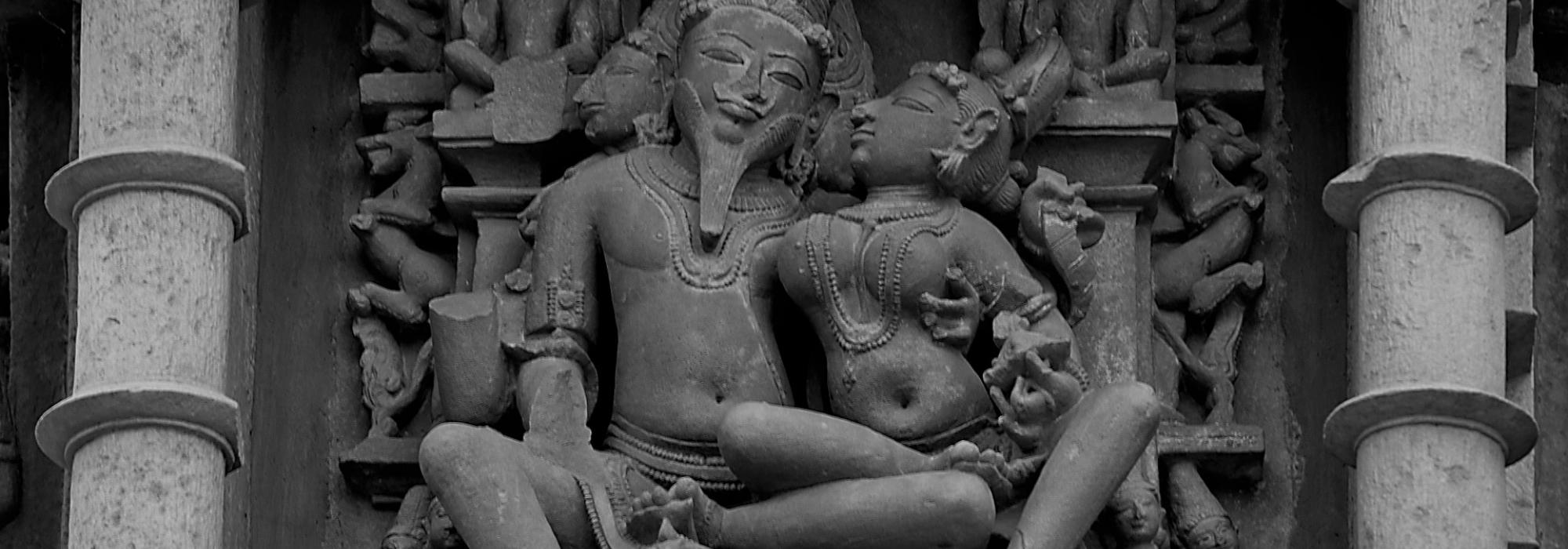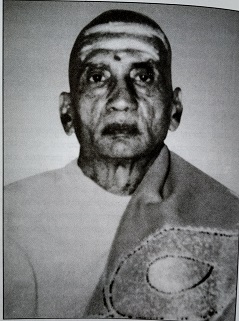The following incident happened in the 1930s, when Śrī Candraśekhara-bhāratī Mahāsvāmi adorned the Śāradā-pīṭha at Sringeri. The Mahāsvāmi’s liking for and support of scholarship is well known. He took great interest in the development of Gīrvāṇa-prauḍha-vidyābhivardhinī Pāṭhaśālā that is housed in the Bengaluru Śaṅkara-maṭha. Back in the day, this Pāṭhaśālā was one of the greatest centres of traditional learning. Rabindranath Tagore, who visited it in 1917, proclaimed, “I have toured the entire country, but it is only in Śaṅkara-maṭha that I have found a Gurukula in line with my imagination.” When Madan Mohan Malaviya, the great national leader and founder of Banaras Hindu University, visited this institution in 1926, he was all praise for the well-roundedness of its curriculum. He enthralled the learned folk of the city for three days by lecturing in Sanskrit on the need to nourish traditional scholarship.
Śrī Candraśekhara-bhāratī Mahāsvāmi took special interest in students studying the scriptures in this Pāṭhaśālā. He used to follow their progress carefully.
A student had completed eight years of learning and had taken up a new śāstra (scripture, science, discipline) for study at the behest of the Mahāsvāmi. He was then struck by misfortune—met with an ugly accident, he underwent multiple surgeries, and was required to stay in bed and receive treatment for a couple of years. This not only halted his studies, but also turned him unfit to make ends meet.
Immediately upon hearing this news, the Mahāsvāmi wrote to the Bengaluru Śaṅkara-maṭha: “For no reason should this gifted student give up learning. Let him receive treatment as appropriate and resume studies later. During the period of medical supervision, all facilities given to him in the Pāṭhaśālā—including the stipend—are to continue in the same manner.”
In this way, it was Śrī Candraśekhara-bhāratī Mahāsvāmi who identified the student’s talent and ensured there were no impediments to his study of the śāstras.
Cultural Invigoration
The Jagadguru’s faith in the student was not unfounded—he became a redoubtable scholar and secured honours at the state and national levels for his mastery of Vedānta philosophy. Apart from teaching the śāstras and masterfully expounding on their nuances in vākyārtha-sabhās[1], he gave discourses on the purāṇas in order to instruct and refine the laity. Through these activities spread over half a century, he singlehandedly disseminated the essence of philosophy and reinvigorated culture.
The person responsible for this efflorescence was Paṇḍita-pravara Māgaḍi Lakṣmīnarasiṃha Śāstri (1913–1994). In those days, the number of traditional scholars was not dwindling as it is today. Even so, Lakṣmīnarasiṃha Śāstri was recognized as the pinnacle of erudition. His house was in the Śaṅkara-maṭha agrahāra[2], and it was common for the womenfolk of this community to reverentially speak of him as “that Śāstri who has read an awful lot.”Consummate scholarship is rare in recent years. Also rare are people who wish to study the śāstras to elevate themselves. In such an environment, Śrī Lakṣmīnarasiṃha Śāstri imparted the knowledge of Vedānta to hundreds of āstikas[3] and thereby ennobled and enlightened their lives.
The mindset to give popular discourses on Mahābhārata, Bhāgavata and suchlike texts is not natural in one who has mastered as many as four śāstras. Lakṣmīnarasiṃha Śāstri was an exception to this because he was unconditionally devoted to utilizing his scholarship for the benefit of the society. Because of this, he came to be known as ‘purāṇada śāstrigaḻu,’ ‘śāstri of the purāṇas.’ He would occasionally remark with a smile, “I don’t belong to the purāṇas; I merely give discourses on them.” Śrī Śāstri had intimate knowledge of the eighteen principal purāṇas, apart from Rāmāyaṇa and Mahābhārata[4]. He was especially fond of Bhāgavata-purāṇa because it discusses philosophical tenets in great detail. Bhāgavatam is the text to test a scholar’s depth of learning — “vidyāvatāṃ bhāgavate parīkṣā.”
Śrī Śāstri dedicated every second of his life to the propagation of Veda, Vedānta, and Purāṇas. The Paramācārya of Kanchi is supposed to have recounted the following saying upon meeting Svāmi Saccidānandendra Sarasvatī of Holenarasipur: “ā supterā mṛteḥ kālaṃ nayedvedāntacintayā,” “Till going to bed every day and till we pass away, we should spend all our time contemplating on the teachings of Vedānta.” Śrī Śāstri was a living embodiment of this ancient saying.
Lineage
A strip of land in Karnataka comprising the provinces of Māgaḍi, Moṭagānahaḻḻi, Soṇḍekoppa, Doḍḍabele, Kuṇigal, and Śivagaṅge has been the thriving ground of scholarship over the past four hundred years. A land alive with scholastic activities, it has produced numerous families of traditional scholars. Śrī Kuṇigal Rāmaśāstri, well known as a great scholar of Nyāya-śāstra (epistemology, logic), whose son went on to become the pontiff of the Śāradā-pīṭha at Sringeri[5], belonged to this land. So did the long line of scholars belonging to the Moṭagānahaḻḻi legacy.
Māgaḍi was the administrative headquarters of Kempegowḍa–I who is best remembered for converting Bengaluru, the present capital-city of Karnataka, into an organized city. Remnants of a fort and the temple of Raṅganātha-svāmi are popular spots of tourism in this locality. Śrī Lakṣmīnarasiṃha Śāstri’s ancestors hailed from this province.
About five generations ago, there lived a vaidika-brāhmaṇa by name Śrī Subbā-bhaṭṭa. He belonged to the Mulakanāḍu subsect, of which there were quite a few homes in Māgaḍi. His son was Lakṣmīnarasiṃha Śāstri, a great scholar of the Vedas. Sūryanārāyaṇa Śāstri, his son, was known as ‘the saint of Māgaḍi.’ He was also known by the name Nārāyaṇa Śāstri. To earn a living, he worked as a teacher in a primary school and officiated as purohita in Vedic rituals. During 1920s, he used to live in the region surrounding the Bengaluru Fort.
Māgaḍi Nārāyaṇa Śāstri used to participate as purohita in Vedic rituals conducted in the homes of several government officials. Once, the following incident transpired: a senior officer of the government was to conduct the annual ceremonial rites of his ancestors. As was the practice, Śrī Nārāyaṇa Śāstri went to his house to have the śrāddha performed. It seems the officer was of a modern bent of mind. He told Nārāyaṇa Śāstri, “Sir, I have had a silk shirt sanctified by dipping it in water. And since it is sanctified, I shall wear it while performing the ritual. There’s no objection, I presume?”
It is against the Vedic code to perform rituals while wearing a stitched garment. Nārāyaṇa Śāstri was of a calm nature and so he did not lose composure at this. Not uttering a word, he stepped out and briskly walked back home. The officer then realized his mistake. Through a messenger, he requested Śrī Śāstri to kindly pardon him and assured he would wear a brahma-vastra while performing the śrāddha. Pleased with this, Śrī Śāstri went to his house and conducted the ritual.
Māgaḍi Lakṣmīnarasiṃha Śāstri was the son of this great person. He was named after his grandfather as per tradition.
Māgaḍi Nārāyaṇa Śāstri’s wife was Śrīmatī Lakṣmīdevamma. The couple had four sons: 1. Rāmaśeṣa Śāstri, 2. Lakṣmīnarasiṃha Śāstri, 3. Subrahmaṇya Śāstri (Śāmaṇṇa), 4, Sūryanārāyaṇa Śāstri. Nārāyaṇa Śāstri had a second wife, and through her he begot three daughters: Indirā, Kamalā, and Śrīlakṣmī, and two sons: Veṅkaṭasubbā Śāstri and Rāmacandra Śāstri.
Rāmaśeṣa Śāstri, the eldest son, took to renunciation at the tender age of eight and was known as Śrī Gaṅgādhara-subrahmaṇya-bhāratī. He was the pontiff of the Śivagaṅgā-maṭha for forty-five years. He shed his mortal body and became one with Brahman in March 1968. Subrahmaṇya Śāstri, the third son, had settled in Bengaluru. He was a purohita (passed away on 27.11.1968). Sūryanārāyaṇa Śāstri, the fourth son, was a professor of Geology in Central College (passed away on 26.1.1973).
Childhood, Education
Lakṣmīnarasiṃha Śāstri was born in Kuṇigal (June 1913). His first teacher was his father, a great scholar himself. Initial lessons on Veda, Sanskrit, and rituals began early in childhood. Lakṣmīnarasiṃha Śāstri began taking lessons on śāstra at the age of twelve. In the course of the next six years, he attained mastery over poetry, drama, grammar, and poetics.
In the 1920s, Śrī Virūpākṣa Śāstri, the scholar par excellence, used to live in the premises of the Bengaluru Śaṅkara-maṭha. Lakṣmīnarasiṃha Śāstri was then in his early teens. He used to accompany his father during his visits to the Maṭha. Whenever people saw him on those occasions, they would think, “This boy will become a prodigious scholar!” Many elders have recounted this to me.
[1] Assembly of scholars to deliberate on scriptural nuances.
[2] A community that houses families of learned Brāhmaṇas.
[3] Adherents of the Vedas. They believe in the existence of svarga, naraka, puṇya, and pāpa.
[4] Typically, Rāmāyaṇa and Mahābhārata are considered texts of Itihāsa (history). Purāṇas are mythological works.
[5] Śrī Saccidānanda-śivābhinava-nṛsiṃha-bhāratī Mahāsvāmi
To be continued.












































